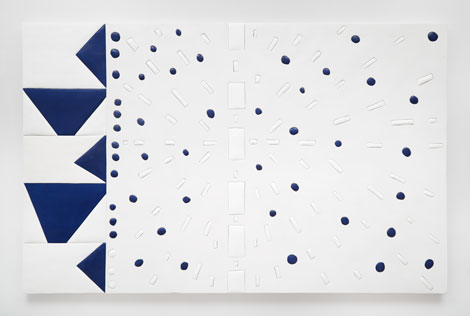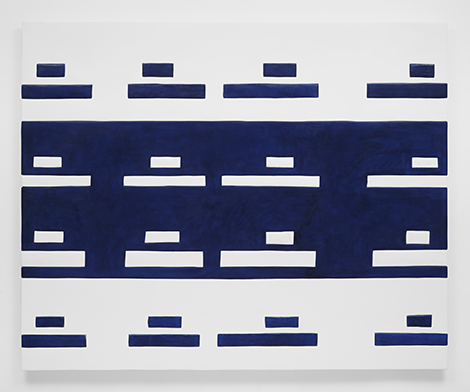Artists known for their breakthrough projects or a specific style often have difficulty changing directions. Fortunately, Sadie Benning has resisted this conundrum, moving successfully between mediums and subjects. Her early works were confessional videos created with a toy (Pixelvision) camera, while more recently she gained attention for the exceptional 2-channel animation Play Pause (2006-7). At present, however, video has moved into the background in favor of nominally abstract paintings.
“Fuzzy Math” is not Benning’s first exhibition of paintings, but it is the largest and one of the first not to have a video component. While at first glance the installation feels more Ellsworth Kelly than Sadie Benning, as the specificity of forms begin to resonate, abstraction begins to suggest a cartoony representation. While the phrase “fuzzy math” has its roots in mathematics, politicians have used it to describe government spending that doesn’t add up. The terminology has entered into popular culture and is readily associated with justification and/or denials of issues ranging from global warming to the wars in the Middle East. Benning has adopted the phrase to infuse her constructed abstractions with socio-political content.

Sadie Benning, Explosion, 2014. Courtesy of Susanne Vielmetter Los Angeles Projects. Photo by Chris Austin.
Benning’s works are labor intensive. She begins by cutting shapes from a single large piece of MDF board. Each shape is subsequently covered with layers of aqua-resin, sanded, painted a single color, and then reassembled to create the finished whole. When put back together, the irregular shapes are not a seamless fit. Gaps are created that become linear reliefs suggesting line drawings. She explores these gaps and the spaces between what is suggested and its depiction. Many of the constructions have real-world referents—pie charts, graphs, hanging chads, explosions, tanks, targets and blood splatters—yet are rendered as simple forms akin to the dots and dashes in Morse code. For example, Tanks (all works 2014) is a blue-and-white composition comprised of rows of larger and smaller rectangles that only resonate as “tanks” upon learning the title.
Explosion functions in a similar manner: blue and white geometric shapes fit within the white ground like complex puzzle pieces.
Without titles the works could remain pure abstractions, as they are often one primary color on white ground. However, knowing Benning’s previous work and her established strong views it seems unlikely that her motivations are to disband narrative intentions in favor of the nonrepresentational. Rather, the work is about repetition, pattern and how a narrative thread can persist through a process of reduction.
While Benning’s hand is implied in her earlier filmic works, it is obvious here. These paintings are pieced and edited together like scenes in a film. Benning begins with the whole then reduces it to a series of fragments, which are then reassembled. She uses a subtractive process to create simple shapes. How these shapes can sign for bigger ideas—rigged elections, the violence of our times—is what Benning is after. Through this fuzzy math, she acknowledges the dissonance between the simplicity of representation and what is being represented.


